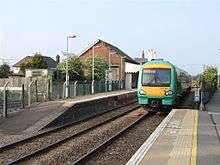Appledore railway station
Appledore railway station is a Grade II listed station east of Appledore in Kent, England. It is on the Marshlink line, and train services are provided by Southern.
| Appledore (Kent) | |
|---|---|
 | |
| Location | |
| Place | Appledore |
| Local authority | Ashford |
| Coordinates | 51.0330°N 0.8164°E |
| Grid reference | TQ975297 |
| Operations | |
| Station code | APD |
| Managed by | Southern |
| Number of platforms | 2 |
| DfT category | F2 |
| Live arrivals/departures, station information and onward connections from National Rail Enquiries | |
| Annual rail passenger usage* | |
| 2014/15 | |
| 2015/16 | |
| 2016/17 | |
| 2017/18 | |
| 2018/19 | |
| History | |
| Key dates | Opened 13 February 1851 |
| Listed status | |
| Listed feature | Railway station |
| Listing grade | Grade II |
| Entry number | 1245943[1] |
| Added to list | 2 July 2001 |
| National Rail – UK railway stations | |
| * Annual estimated passenger usage based on sales of tickets in stated financial year(s) which end or originate at Appledore (Kent) from Office of Rail and Road statistics. Methodology may vary year on year. | |
The station was constructed in 1851 by the South Eastern Railway and designed by William Tress. It became a junction station in 1881 when a branch line opened to Lydd and New Romney; this closed to passengers in 1967 following the Beeching Report, though the line remains open for goods traffic to Dungeness Nuclear Power Station. Despite a recommendation in the report that Appledore should also close, it has remained open into the 21st century.
Name and location

According to National Rail, this station's official name is Appledore (Kent), despite the other Appledore station in Devon having closed in 1917. On official documents and railway company websites, the station is referred to as Appledore (Kent), although signs at the station simply list 'Appledore'.[2][3]
The station is located almost two miles from Appledore village and 8 1⁄2 miles (13.7 km) south of Ashford International, on the B2080, a local road. Owing to its distance from the village, it is in the Parish of Kenardington, not Appledore.[4][5]
Appledore is just north of a junction of a freight branch line running to Dungeness nuclear power station via Lydd.[6] Appledore is also the start of the single track section of the Marshlink line, which runs through to Ore near Hastings with a passing loop at Rye.[7] Along with several other stations on the line, the platforms are staggered.[4]
When British Rail introduced widespread provision of enamel totem station signs Appledore was one of very few that had some wooden ones fitted.[8]
History
The station was first proposed by the South Eastern Railway (SER) in June 1848 as a stop on the Ashford to Hastings line. That September, hop planters near Appledore petitioned the early construction of the line to help with harvest; however a formal decision to build a station was not taken until June 1850.[9]
The station was designed, along with others along the line, by William Tress. The main building was built in an Italianate style with red brick with a Welsh slate roof.[4][1] It opened, along with the rest of the line on 13 February 1851.[10] A pub, the Man of Kent Railway Tavern was built in 1853 on the opposite side of the road (now the B2080). It was rebuilt adjacent to the station in the late 19th century.[4] A waiting room was built in 1894, followed by a goods shed in 1896 and a station master's house the following year.[11]
In 1881, Appledore was upgraded to become a junction station to cater for a branch line to Lydd, with new signals installed. The branch line opened on 7 December, and was further extended to New Romney in 1884.[4][11] The station platforms were widened in June 1887 to accommodate longer trains.[11] A line was also proposed from Appledore to Tenterden, but this was never built.[4]
The SER subsequently merged with the London, Chatham and Dover Railway to form the South Eastern and Chatham Railway.[12] It became part of the Southern Railway during the Grouping of 1923. The station then passed on to the Southern Region of British Railways on nationalisation in 1948.[4]
The goods shed was closed in 1963.[13] Appledore ceased to be a junction station for passengers when the branch line to Lydd and New Romney closed in 1967. However, it continued to be used for goods traffic to Dungeness.[14]
When Sectorisation was introduced in the 1980s, the station was served by Network SouthEast until the Privatisation of British Railways.
In 2001, the station building and goods shed were Grade II listed. The main building is in good condition and has been largely unaltered since its original 1851 construction.[1][13]
Accidents and incidents
- On 14 March 1980, an empty stock train comprising five Hastings Unit vehicles derailed due to excessive speed through a set of points. The driver was killed. A motor coach was consequently withdrawn from service due to extensive damage.[15]
- On 31 July 1989, 2H diesel-electric multiple unit 205 101 collided with a van on the level crossing.[16]
Services
Trains run once an hour during the day in each direction, north to Ashford and south to Hastings and beyond to/from Eastbourne via Bexhill. Until May 2018, the southbound service ran as an express service to Brighton , but this was discontinued due to long journey times and lack of rolling stock, which frequently caused overcrowding, which was especially true between Brighton and Eastbourne. The rolling stock is Southern diesel Class 171 Turbostars, used on the non-electrified Marshlink route.[17] APTIS was once provided here until the booking office closed in the very early 1990s leaving no ticketing facilities. In 2016 Southern installed a new self-service ticket machine. The office buildings on the Ashford-bound platform are unused.
| Preceding station | Following station | |||
|---|---|---|---|---|
| Rye | Southern Marshlink Line |
Ham Street | ||
| Disused railways | ||||
| Terminus | BR Southern Region Marshlink - Dungeness branch |
Brookland Halt Line open, station closed | ||
References
Citations
- Historic England. "Appledore Railway Station (1245943)". National Heritage List for England. Retrieved 2 October 2019.
- "Appledore (Kent) (APD)". National Rail. Retrieved 3 October 2019.
- Julia Barnes; Maureen Richards; Anthony Barnes (2013). Northam, Westward Ho! & District Through Time. Amberley Publishing Limited. p. 82. ISBN 978-1-4456-1861-6.
- "Appledore Station area and Railway". Appledore Local History Society. Retrieved 3 October 2019.
- "The Village". Appledore Local History Society. Retrieved 3 October 2019.
- Gray 1990, p. 228.
- Sissons 2008, p. 411.
- "Appledore had wooden totems". Railwayana website. 4 May 2018. Retrieved 4 May 2018.
- Gray 1990, pp. 209-211.
- Gray 1990, p. 211.
- Gray 1990, p. 213.
- Gray 1990, p. 52.
- Historic England. "Goods Shed at Appledore Railway Station (1245944)". National Heritage List for England. Retrieved 15 October 2019.
- "Kent railway lines that have been closed for decades could be reopening". Kent Live. 30 November 2017. Retrieved 2 October 2019.
- Beecroft 1986, p. 63.
- McCrickard, John P (6 October 2016). "January 1989 to December 1989". Network South East Railway Society. Archived from the original on 26 June 2018. Retrieved 26 June 2018.
- "Marshlink's reliability". Rye News. 5 July 2018. Retrieved 27 September 2019.
Sources
- Beecroft, Geoffrey (1986). The Hastings Diesels Story. Chessington: Southern Electric Group. ISBN 0-906988-20-9. OCLC 17226439.CS1 maint: ref=harv (link)
- Gray, Adrian (1990). South Eastern Railway. Middleton Press. ISBN 978-0-906520-85-7.CS1 maint: ref=harv (link)
- Sissons, Rob (2008). Single Track Obsession: A Book of Extraordinary Railway Journeys. Trafford Publishing. ISBN 978-1-4251-6239-9.CS1 maint: ref=harv (link)
- Butt, R. V. J. (1995). The Directory of Railway Stations: details every public and private passenger station, halt, platform and stopping place, past and present (1st ed.). Sparkford: Patrick Stephens Ltd. ISBN 978-1-85260-508-7. OCLC 60251199.
- Jowett, Alan (2000). Jowett's Nationalised Railway Atlas (1st ed.). Penryn, Cornwall: Atlantic Transport Publishers. ISBN 978-0-906899-99-1. OCLC 228266687.
External links
| Wikimedia Commons has media related to Appledore (Kent) railway station. |
- Train times and station information for Appledore railway station from National Rail
- Appledore at Disused Stations - history about the station and lines